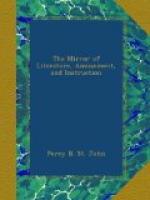NEW BUILDINGS, INNER TEMPLE.
[Illustration: New Buildings, Inner Temple.]
“The Temple,” as our readers may be aware, is an immense range of buildings, stretching from Fleet-street to the River Thames, north and south; and from Lombard-street, Whitefriars, to Essex-street, in the Strand, east and west. It takes its name from having been the principal establishment, in England, of the Knights Templars; and here, in the thirteenth century they entertained King Henry III., the Pope’s Nuncio, foreign ambassadors, and other great personages. The king’s treasure was accustomed to be kept in the part now called the Middle Temple; and from the chief officer, who, as master of the Temple, was summoned to Parliament in the 47th of Henry III., the chief minister of the Temple Church is still called Master of the Temple. After the suppression of this once celebrated order,[1] the professors of the common law purchased the buildings, and they were then first converted into Inns of Court, called the Inner and Middle Temple, from their former relation to Essex House, which as a part of the buildings, and from its situation outside the division of the city from the suburbs formed by Temple Bar, was called the Outer Temple.
[1] In the Temple Church,
lie the remains, marked out by their
effigies, of numbers of the
Templars. For a Description and
Engraving of the Church, see
mirror, No. 274.
The principal part, or what we might almost call the nucleus of the Inner Temple, is the Hall and Chapel, which were substantially repaired in the year 1819. Thence a range of unsightly brick buildings extended along a broad paved terrace, to the south, descending to the Garden, or bank of the Thames. These buildings have lately been removed, and the above splendid range erected on their site, from the designs of Robert Smirke, Esq., R.A. They are in the Tudor, or to speak familiarly, the good Old English school of architecture, and combine all the picturesque beauty of ancient style with the comfort and elegance of modern art in the adaptation of the interior. Our succinct sketch of the origin of the Temple will sufficiently illustrate the appropriateness of Mr. Smirke’s choice. Over the principal windows, on escutcheons, are the Pegasus, the Temple arms, and the respective arms of Henry III. and George IV. At the end immediately adjoining the Chapel, is a Latin inscription with the date of the repairs, 1819, and at the eastern extremity of the present building is another inscription with the date of 1828, in which the last improvements were commenced. Viewed from the Terrace, the whole range has a handsome and substantial appearance, sufficiently decorated, yet not overloaded with ornament. From another point, Whitefriars Gate, the end of the building, with its fine oriel window, is seen to considerable advantage. Against the old brick house on this spot was a sun-dial, with the quaint conceit, “Begone about your business.” The cast-iron railing of the area appears to us extremely elegant and appropriate.




